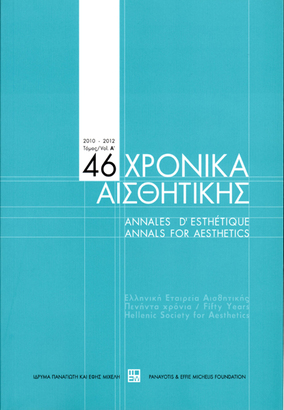Leibniz εναντίον Descartes : από τη μοντέρνα αρχιτεκτονική στην αρχιτεκτονική της πτύχωσης
Part of : Χρονικά αισθητικής : ετήσιον δελτίον της Ελληνικής Εταιρείας Αισθητικής ; Vol.45, 2009, pages 105-135
Issue:
Pages:
105-135
Parallel Title:
Leibniz vs Descartes : from modern to folding architecture
Author:
Abstract:
During the 17th century, the search for the ultimate principles of nature within its quantitive features, led man to put forward supra-empirical, mathematical laws. Hence, the ontological question was substituted by the problem of function, that is to say the unchangeable and, in this sense, true mathematical laws which underlie the physical world on the basis of experience.The stemming of truth from the mind, and the mechanistic consideration of matter, as well as the supra-empirical power which the notion of function acquires through its mathematical formulation, constitute the basic characteristics which Descartes bequeathed to the Modern Movement architecture in the beginning of the 20th century, through the enormous influence he exerted upon the evolution of science and technology during the 18th and 19th centuries. The principal role of the causal relation between form and function, and the implied dominance of function, as well as the separation of form from any metaphysical foundation, constitute the fundamental principles of the Modern avant-garde, from Constructivism and the Bauhaus to De Stijl and Expressionism. On the other hand, the Cartesian co-ordinates, as a means of graphical representation of the mathematical laws which govern the universe of Modernity, abolish the one, absolute centre of reference, in favour of a quantitive classification of the attributes, which bear an empirical meaning. The use of the modulus in architectural design and the founding of structural mechanics - as early as in the 18th century - could be considered as expressions of a Cartesian order in space.Leibniz, who was born a few years after Descartes’ death, in the midseventeenth century, attempts to unify ontology with epistemology through a mathematical conception of the world, as an expression of the divine mind. Through the infinitesimal calculus, the Cartesian analysis of the world into minimal parts or minima has been replaced by Leibniz by a continuous, infinitely folding and unfolding universe, occupied by matter and souls. Within this universe, the form of the bodies incorporates the notion of time, by being identified with the function of external or internal forces. The linear, homogenous, limited, static Cartesian space has been replaced by a space which is dynamic, heterogeneous, open. This implies a theatrical conception of a labyrinthine space. The recreation of such a universe - where the infinite constitutes a characteristic of wholeness, and difference is an expression of continuity - represents the aim of the avant-garde of contemporary architecture.
Subject:
Subject (LC):
Keywords:
μοντέρνα αρχιτεκτονική, μπαρόκ τέχνη
Notes:
Η διάλεξη πραγματοποιήθηκε στις 19 Νοεμβρίου 2008, Περιέχει εικόνες




